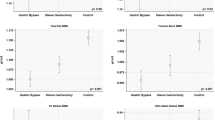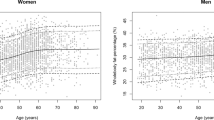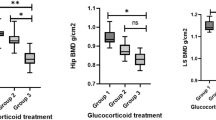Abstract
Background/Objectives:
Restrictive Anorexia nervosa (ANR) is an eating disorder (ED) characterized by a low bone mineral content (BMC) and by an alteration in body composition (reduction and abnormal distribution of fat mass—FM and lean mass—LM). The aim of our study was to address whether bone and body composition changes could be influenced by hormonal status and sport in female adolescents with restrictive anorexia nervosa-ANR.
Subjects/Methods:
Prospective study on 79 adolescents with ANR submitted to Dual Energy X-Ray Absorptiometry—DXA at baseline-T0 and after 12 months-T12. Among the 46/79—58.2% patients that completed the study, we evaluated total and regional FM and LM%, as well as lumbar bone mineral density (BMD) and Z-score, linking them to clinical variables: menarche/amenorrhea/hormonal therapy and physical activity.
Results:
At T0: body mass index (BMI)=16.4±1.4 kg/m2 with low levels of FM% (21.7±5.7) low BMC in 12/46—26.0% (mean Z-score: −1.21±1.27, with higher values related to physical activity—P=0.001). At T12: a significant increase in BMI—P=0.001, with LM reduction and FM increase (more evident in the trunk—P<0.001); regarding bone, no significant changes were observed, though a tendency in terms of improvement associated with resumption of menses.
Conclusions:
After 1 year, weight recovery was not associated with a reestablishment of bone values; by contrast, it was associated with an increase and a distortion in FM distribution, more evident in trunk region (potential and adjunctive risk factor for the relapse of the psychiatric condition). The complexity of these clinical findings suggested DXA, a low-dose and low-cost technique, in long-term monitoring of ANR patients.
This is a preview of subscription content, access via your institution
Access options
Subscribe to this journal
Receive 12 print issues and online access
$259.00 per year
only $21.58 per issue
Buy this article
- Purchase on Springer Link
- Instant access to full article PDF
Prices may be subject to local taxes which are calculated during checkout

Similar content being viewed by others
References
Bulik CM, Reba L, Siega-Riz AM, Reichborn-Kjennerud T . Anorexia nervosa: definition, epidemiology, and cycle of risk. Int J Eat Disord 2005; 37: S2–S9.
Horst-Sikorska W, Ignaszak-Szczepaniak M . The role of anorexia nervosa in secondary osteoporosis development with the risk for low energy fractures. Endokrynol Pol 2011; 62: 45–47.
Mehler PS, MacKenzie TD . Treatment of osteopenia and osteoporosis in anorexia nervosa: a systematic review of the literature. Int J Disord 2009; 42: 195–201.
Ecklund K, Vajapeyam S, Feldman HA, Buzney CD, Mulkern RV, Kleinman PK et al. Bone marrow changes in adolescent girls with anorexia nervosa. J Bone Miner Res 2010; 25: 298–304.
Mehler PS, Cleary BS, Gaudiani JL . Osteoporosis in anorexia nervosa. Eat Disord 2011; 19: 194–202.
Misra M, Miller KK, Almazan C, Worley M, Herzog DB, Klibanski A . Hormonal determinants of regional body composition in adolescent girls with anorexia nervosa and controls. J Clin Endocrinol Metab 2005; 90: 2580–2587.
American Psychiatric Association. Diagnostic and Statistical Manual for Mental Disorders 4th edn Text Revision (DSM-IV-TR), American Psychiatric Association: Washington, DC, 2000.
Garner DM Eating Disorder Inventory-3. Professional Manual. Psychological Assessment Resources, Italian adaptation by Marco Giannini, Linda Pannocchia, Riccardo Dalle Grave, Filippo Muratori e Valentina Viglione: Lutz, FL. Giunti, O.S: Florence 2004.
Hathaway SR, McKinley JC . Minnesota Multiphasic Personality Inventory-2. Handbook, University of Minnesota Press: Minneapolis, 1989, trad. it. Pancheri P, Sirigatti S. Minnesota Multiphasic Personality Inventory-2. Manuale, Giunti O.S.: Florence, 1995.
Butcher JN, Williams CL, Graham JR, Archer RP, Tellegen A, Ben-Porath YS et al MMPI-A (Minnesota Multiphasic Inventory for Adolescents): Manual for administration, scoring and interpretation. University of Minnesota Press: Minneapolis, 1992.
First MB, Gibbon M et al User’s Guide for Structured Clinical Interview for DSM-IV Axis II Personality Disorders (SCID-II). American Psychiatric Press: Washington DC, 1997.
Cianchetti C, Sannio Fascello G . Scale Psichiatriche di Autosomministrazione per Fanciulli e Adolescenti (SAFA). Giunti, O.S.: Florence, 2001.
Achenbach TM . Manual for the Child Behavior Checklist/4–18 and 1991 Profile. University of Vermont Department of Psychiatry: Burlington, VT, 1991.
Baim S, Leonard MB, Bianchi ML, Hans DB, Kalkwarf HJ, Langman CB et al. Official positions of the International Society for Clinical Densitometry and Executive Summary of the 2007 ISCD Pediatric Position Development Conference. J Clin Densitom 2008; 11: 75–91.
Miller KK . Endocrine dysregulation in anorexia nervosa update. J Clin Endocrinol Metab 2011; 96: 2939–2949.
Kullberg J, Brandberg J, Angelhed JE, Frimmel H, Bergelin E, Strid L et al. Whole-body adipose tissue analysis: comparison of MRI, CT and dual energy X-ray absorptiometry. Br J Radiol 2009; 82: 123–130.
Grinspoon S, Thomas E, Pitts S, Gross E, Mickley D, Miller K et al. Prevalence and predictive factors for regional osteopenia in women with anorexia nervosa. Ann Intern Med 2000; 133: 790–794.
Valla A, Groenning IL, Syversen U, Hoeiseth A . Anorexia nervosa: slow regain of bone mass. Osteoporos Int 2000; 11: 141–145.
Miller KK, Lee EE, Lawsan A, Misra M, Minihan J, Grinspoon SK et al. Determinants of skeletal loss and recovery in anorexia nervosa. J Clin Endocrinol Metab 2006; 91: 2931–2937.
Lambrinoudaki I, Papadimitriou D . Pathophysiology of bone loss in the female athlete. Ann NY Acad Sci 2010; 1205: 45–50.
Gordon CM, Goodman E, Emans SJ, Grace E, Becker KA, Rosen CJ et al. Physiologic regulators of bone turnover in young women with anorexia nervosa. J Pediatr 2002; 141: 64–70.
Mayer L, Walsh BT, Pierson RN Jr, Heymsfield SB, Gallagher D, Wang J et al. Body fat redistribution after weight gain in women with anorexia nervosa. Am J Clin Nutr 2005; 81: 1286–1291.
Grinspoon S, Thomas L, Miller K, Pitts S, Herzog D, Klibanski A . Changes in regional fat redistribution and the effects of estrogen during spontaneous weight gain in women with anorexia nervosa. Am J Clin Nutr 2001; 73: 865–869.
Misra M, Soyka LA, Grinspoon S, Levitsky LL, Klibanski A . Regional body compositions in adolescents with anorexia nervosa and changes with weight recovery. Am J Clin Nutr 2003; 77: 1361–1367.
Mayer LES, Klein DA, Black E, Attia E, Shen W, Mao X et al. Adipose tissue distribution after weight restoration and weight maintenance in women with anorexia nervosa. Am J Clin Nutr 2009; 90: 1132–1137.
Bazzocchi A, Diano D, Battista G . How fat is fat? Lancet 2012; 380: e1.
Acknowledgements
We wish to thank FANEP Onlus (Famiglie di Neurologia Pediatrica) for its support and daily assistance to children and their families. Neither I nor my immediate family members received any support for the work, in form of grants and/or equipment and drugs. The same statement applies to all other authors.
Author information
Authors and Affiliations
Corresponding author
Ethics declarations
Competing interests
The authors declare no conflict of interest.
Rights and permissions
About this article
Cite this article
Franzoni, E., Ciccarese, F., Di Pietro, E. et al. Follow-up of bone mineral density and body composition in adolescents with restrictive anorexia nervosa: role of dual-energy X-ray absorptiometry. Eur J Clin Nutr 68, 247–252 (2014). https://doi.org/10.1038/ejcn.2013.254
Received:
Revised:
Accepted:
Published:
Issue Date:
DOI: https://doi.org/10.1038/ejcn.2013.254
Keywords
This article is cited by
-
Anorexia Nervosa and Osteoporosis
Calcified Tissue International (2022)
-
Assessment and clinical management of bone disease in adults with eating disorders: a review
Journal of Eating Disorders (2017)
-
The role of DXA in sarcopenia
Aging Clinical and Experimental Research (2016)
-
Body composition in young female eating-disorder patients with severe weight loss and controls: evidence from the four-component model and evaluation of DXA
European Journal of Clinical Nutrition (2015)
-
Underweight, Overweight, and Pediatric Bone Fragility: Impact and Management
Current Osteoporosis Reports (2014)



